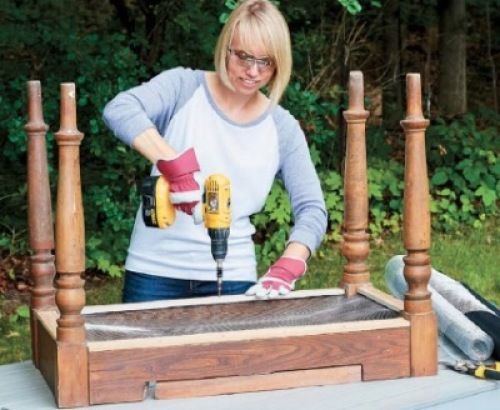
Tara Nolan is a garden writer and editor who lives in Dundas, Ontario. Her writing has appeared in the Toronto Star, one of Canada’s national newspapers, as well as in Reader’s Digest and Canadian Living, and on websites like Design*Sponge. She’s a co-founder of Savvy Gardening and was the award-winning editor of Canadian Gardening magazine’s website for six years.
Her first gardening book, Raised Bed Revolution (Cool Springs Press, 2016) covers everything raised-bed related, from construction to DIY ideas for creating raised planting spaces that overflow with vegetables, herbs and pollinator-attracting flowers.
The book features multiple projects for spaces both big and small with step-by-step photos, instructions, and technical illustrations. There are dozens of inspirational photos, as well as gardening tips.
“There are so many benefits to planting in raised beds, from accessibility to enjoying an earlier and later planting season,” she writes. “An Ohio State University Extension Fact Sheet explains that over three years, a raised bed produced 1.24 pounds of edibles per square foot, which is more than double the yield of what is grown in a conventional garden.”
Tara took time from her writing and gardening schedule to answer a few questions about getting started with raised bed gardening:
Raised bed gardening has been around a long time-why the renewed interest?
“I think raised bed gardening is a relevant entry point for people, especially those who don’t see themselves as traditional gardeners. Raised beds allow people to garden in spaces both big and small, provided they have that necessary six to eight hours of sunshine a day. Furthermore, edible gardens are no longer relegated to a flat expanse of backyard. You see more and more raised beds in front and side yards, schoolyards and vacant properties. At some of my talks, the audience is a mix of people, from seasoned green thumbs to elderly people who like the appeal of raised beds because of their accessibility, and young couples who are wanting to plant their first gardens.”
What are the top 3 ideas to keep in mind about gardening in raised beds?
“One thing I wish I had done with my first beds was add some sort of stake to the midpoints to keep the beds more uniform. Over time, the wood is still good and they’ve maintained their shape for the most part, but in the centre of the longest boards, they have shifted a little.
Another thing gardeners will want to think about if they have one raised bed and limited space is to train plants, like squash and cucumbers, to grow upwards, like on a squash arch or trellis.
Lastly, you may want to avoid putting perennial edibles, like asparagus, in your raised beds, since over time, you may have to replace the beds and it will be hard to move plants once they’re well established.”
What’s an example of a new type of material for raised vegetable bed gardens?
There are some great fabric raised beds on the market made from recycled materials that can withstand the elements (like Woolly Pocket and Les Urbainculteurs). Fabric aerates the roots of your edibles promoting healthy growth. The best part is you can empty them in the fall, fold them up and store them for winter.
Can raised beds help save water over traditional vegetable beds?
There are a few ways that raised beds can help conserve water. They do promote better drainage and aeration as the soil remains loose and friable when it’s not being walked on. Planting edibles close together will also keep the soil cool and conserve moisture as will a light layer of mulch, such as straw. Installing an irrigation system will help you save water as the emitters placed along the hose will deliver the water directly to the roots of the plants and you lose less water to evaporation.
What’s your favorite soil for using in a raised vegetable bed?
When I was filling all my raised beds last summer, I ordered the best triple mix I could find from a local supplier and top-dressed it with organic compost. I recommend the best that you can afford.
Anything else you’d like to add?
“I think a raised bed can instantly transform a garden space. It neatens up the area, but many also become part of the landscape. There are so many options available these days, from steel raised beds that age to a lovely patina to stock tanks.”



















Comments
It is so useful! https://www.finegardening.com/article/meet-tara-nolan-raised-bed-revolutionary
Log in or create an account to post a comment.
Sign up Log in